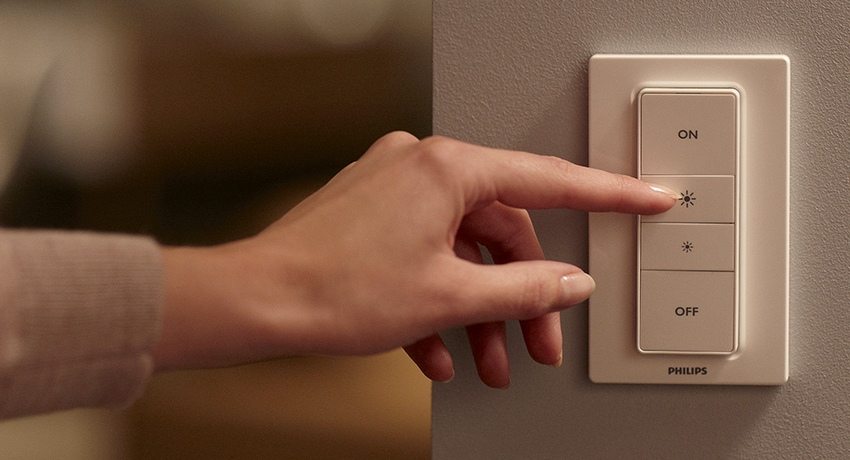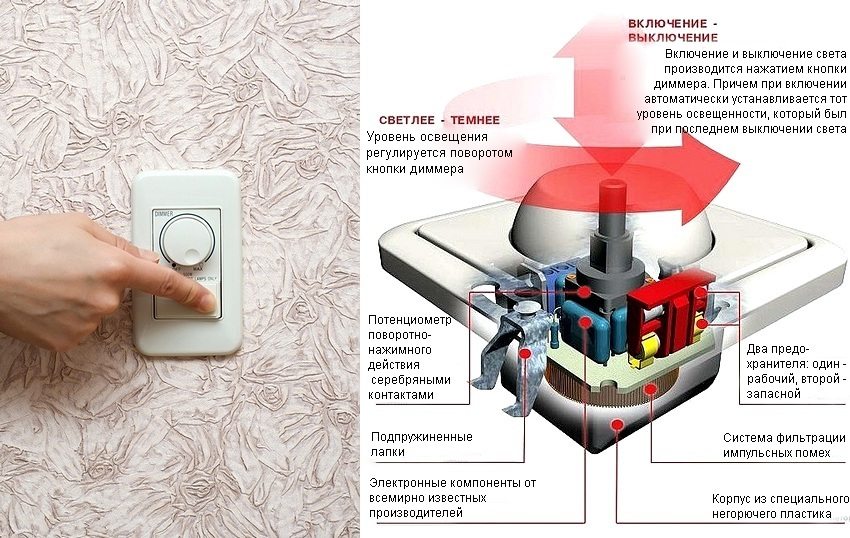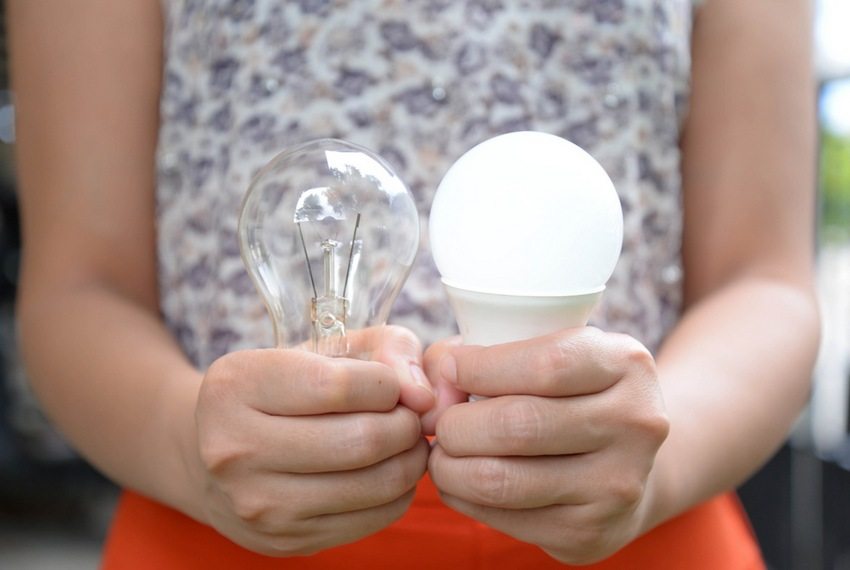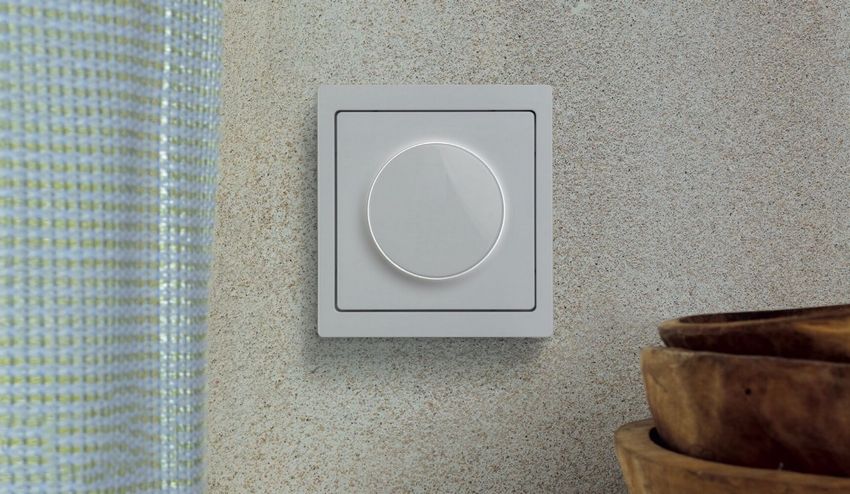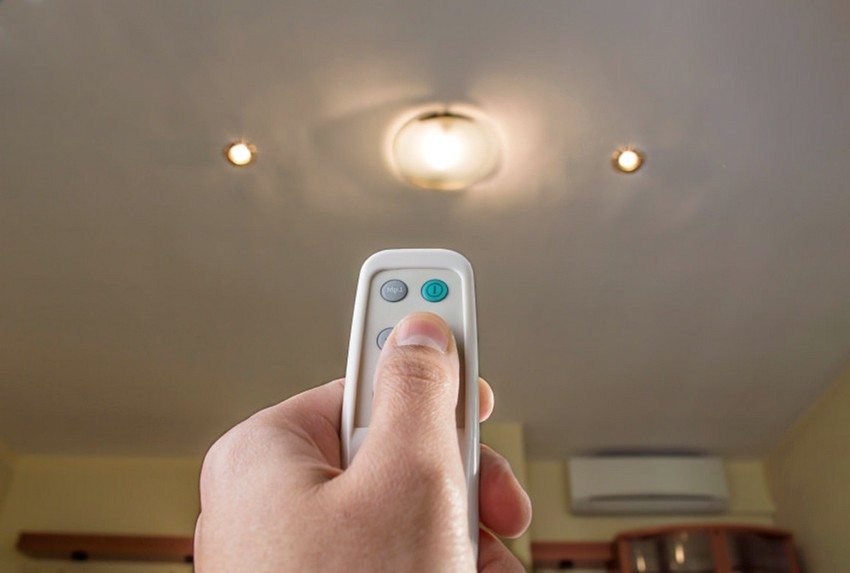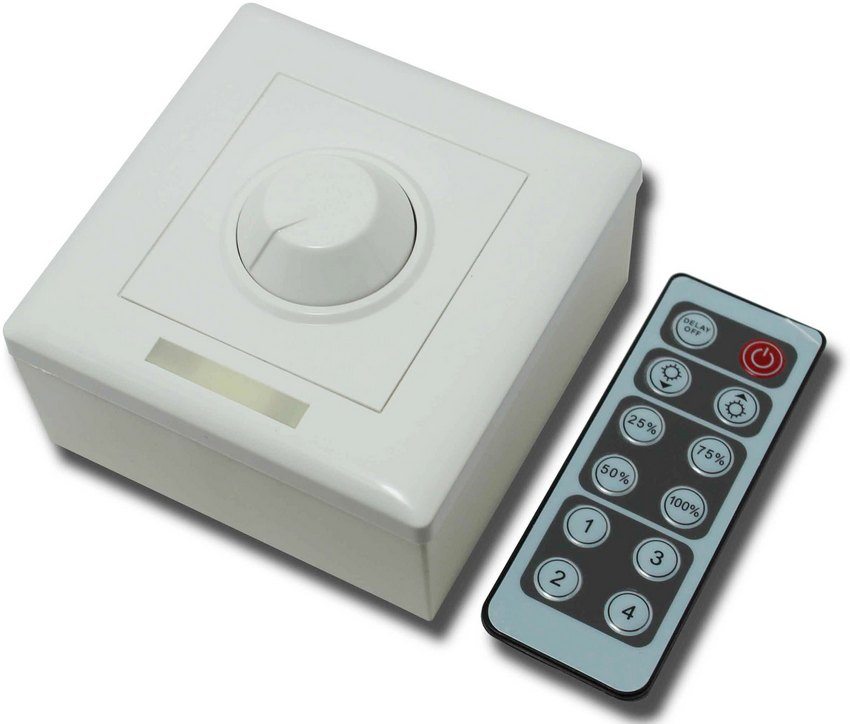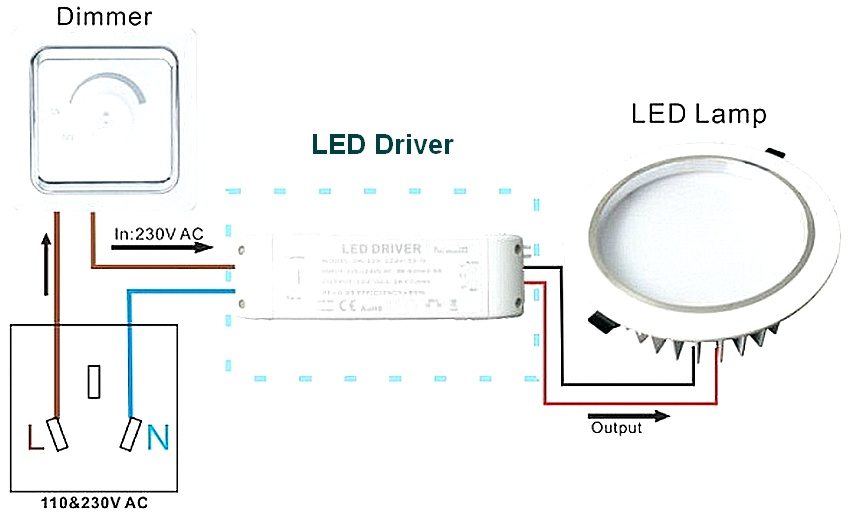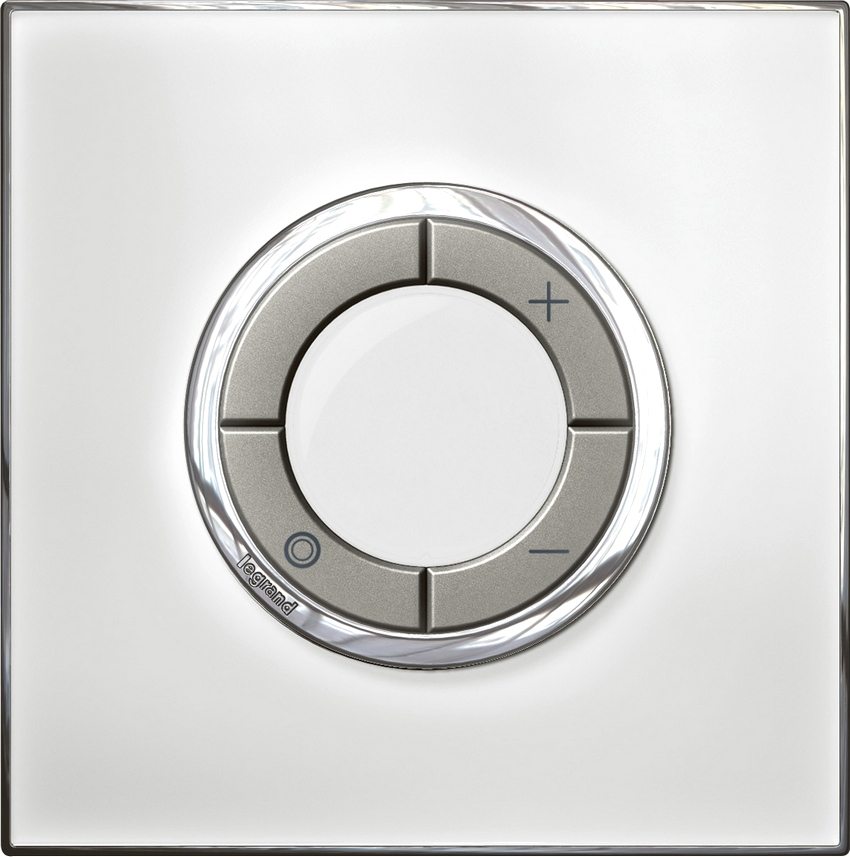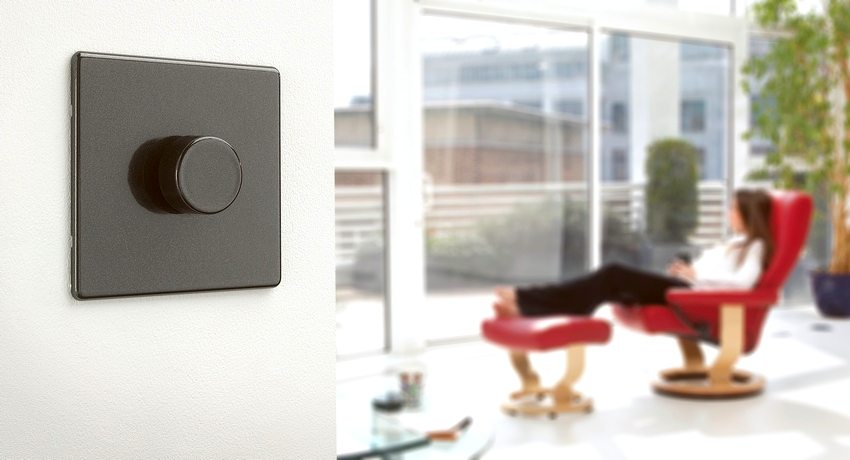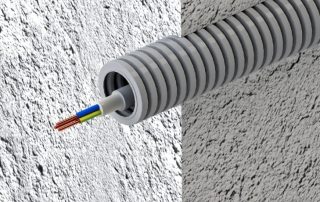In order for the interior lighting to work according to the chosen scenario, special devices are used that regulate the brightness of the glow. Such wiring devices allow you to stepwise or smoothly change the load applied to the light sources. Dimmers for 220V LED lamps not only control the luminous flux, but also contribute to energy saving and a long service life.
Content [Hide]
- 1 Dimmer: what is this device and how it works
- 2 Dimmers for LED lamps
- 3 Dimmers for LED lamps 220V: types, circuits and device connection
- 4 Dimming from multiple locations: how the pass-through dimmer works
- 5 Dimmer manufacturers: where to buy dimmers for 220V LED lamps
- 6 Making a dimmer with your own hands
Dimmer: what is this device and how it works
Dimmer is a multifunctional switch designed to control the luminous flux of incandescent lamps, fluorescent light sources and LED lamps. Initially, such devices were controlled mechanically, and their function was only to change the brightness of various light sources. Modern dimmers are endowed with microcircuits (microcontrollers) designed to perform a number of functions:
- changing the glow level;
- smooth shutdown and inclusion of the light source;
- the effect of being in the house (this function allows you to maintain the scenario of simulating the presence of the owners in the dwelling, periodically turning the light on and off);
- automatic disconnection from the network;
- support for a series of flashing and dimming modes;
- possibility of electronic, remote and acoustic control.
Dimmers can be installed individually or in groups, controlling the operation of one or more luminaires, respectively. If several light sources are combined to illuminate a zone, they can be connected to one dimmer. With its help, it will be possible to change the brightness of the glow using a special remote control panel.
The dimmer device is based on the rheostat principle. By changing the resistance of the circuit, you can change the voltage or current value. The higher the resistance value, the lower the electric current voltage. The dimmer device has a set of resistors, through which the intensity of the glow is regulated. Using a dimmer, you can set a comfortable level of lighting, taking into account the fact that at different times the lighting requirements of the premises may be different.
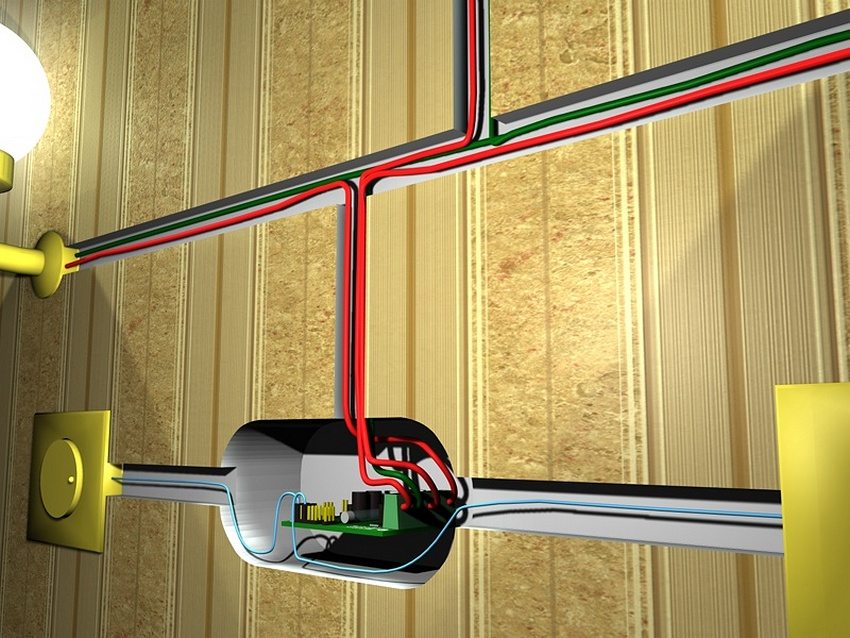
Dimmer connection principle for LED lamps
Thus, the use of such devices makes it possible to implement not only a variety of design solutions, but also significantly reduce energy consumption costs.
Note! Operating in a soft dimmed mode, incandescent bulbs and LED luminaires can last 5-10 times longer.
Dimmers for LED lamps
Depending on which light sources the dimmers are used for, they are classified into:
- dimmer control for incandescent lamps;
- dimmers for LEDs;
- dimmers for 220V LED lamps;
- dimmers for energy-saving lamps (fluorescent).
It should be noted that, unlike LED strips and designs, semiconductor lamps can be connected to a 220V household network without using voltage converters. Their power is up to 40W. When replacing conventional incandescent lamps with LED light sources, you need to familiarize yourself with the technical characteristics of the latter: voltage, power, color temperature, type of base, service life. All these data can be found on the product packaging.
The LED lamps are equipped with a base that is adapted to the standard lamp holder. They are available with E, MR and G (male) base. The presence of threaded socles for dimmable LED lamps E14, E27 makes them convenient for connecting to a 220V household lighting system and allows you to use standard dimmers for them.
Not all control devices are compatible with LED lamps. In order for the buyer to understand whether it is possible to adjust the brightness of the luminescence of the purchased products, manufacturers put an indication of this possibility on the packaging and in the passport of the LED lamp. It can be either a corresponding inscription or a symbol.
By purchasing a dimmed LED lamp, you can save on purchasing a special dimmer. For lamps in which the dimming function is not incorporated, dimmers for LED lamps are used that work on the principle of pole-width modulation (PWM), which are quite expensive.
Dimmers for LED lamps 220V: types, circuits and device connection
Connecting a standard dimmer for non-dimmable LED lamps requires a certain amount of power up to 45W. So, the power of one incandescent lamp can be produced by two or even three semiconductor lamps 220V. If the load is not enough, LED lamps will not work correctly and quickly fail without the possibility of warranty replacement.
Dimmer classification
You can choose a dimmer model that would maximize energy saving and increase the life of LED lamps when reviewing the classification and technical parameters of dimmers. They differ in design, current load, control principle, installation method and other characteristics.
By the way of control, dimmers are classified into:
- touch (contact) - control of such devices occurs through contact with the touch panel;
- rotary-push - the start occurs by pressing the handle (large round button), and brightness control - by turning. The main feature of such devices is that you can turn off the lighting in the selected mode, without bringing the handle to its original position;
- keyboards - models with buttons or keys that adjust the light level. Usually in such dimmers there is a disconnect key from the mains, like a conventional switch;
- remote - the luminous flux is adjusted using the remote control or wirelessly (Wi-Fi).
Note! Due to the absence of moving elements in the design, touch dimmers are the most reliable and high-quality in relation to other models.
Depending on the installation location, dimmers are divided into the following types:
- wall-mounted - mounted at the location of the switch in the rooms where the control of the light flux is planned;
- remote - look like a small block installed next to the lamp;
- modular - they are installed in the distribution box on a DIN rail to which they are attached RCD, automatic protection switches and other devices.
By the way of electrical installation, dimmers are divided into devices for outdoor and hidden wiring.
Dimmer circuit for a 220V LED lamp
The first simple dimmers were used only to change brightness. Their device included a rotary knob and a connection terminal. Such devices worked without saving electricity, since the released power simply disappeared in the form of unnecessary heat. With the advent of semiconductor electronic devices (dinistors and triacs), the functions of dimmers have expanded significantly.
The principle of operation of a dimmer circuit on a triac is to pass current through it. In such dimmers, the main controlled element is the triac. The power of the load connected to such a circuit depends on its parameter. Due to the appearance of voltage between the electrodes of the triac A1 and G, the lamp lights up.
The charging rate depends on the value of the potentiometer R, which is charged at the beginning of the positive half-wave. When the resistance indicator on the triac reaches its minimum value, it opens and the lamp glows until the end of the half-wave. The same picture is observed in the case of a negative half-wave, since the current in the triac is transferred in both directions.
Thus, the voltage across the active load is a section of negative and positive half-waves, going one after another with a frequency of 100 Hz. At a very low brightness of the light bulb, its flickering can be observed. This is due to the fact that the lamp power is very short.
The circuitry of various triac dimmers for LED lamps is almost identical everywhere, and may differ in additional elements for stable operation at low voltage “outputs”. In some cases, details are added to the circuit for smoother control of the luminous flux and elements that reduce the level of interference in the network.
How to connect a dimmer
Recently, to control lighting, many replace conventional switches with dimming devices. The dimmer, like the switch, has two clamps and is mounted in place of the junction box using the same wires that were used for the household switch. Using a fairly simple dimmer wiring diagram, anyone can install a dimmer.
Note! The installation of the dimmer must be carried out adhering to the safety rules for electrical work.
The procedure for connecting a dimmer for 220V LED lamps with your own hands:
- using an indicator screwdriver, it is necessary to determine the phase;
- de-energize the household power supply;
- guided by the dimmer circuit for LED lamps, the wire with a phase should be connected to the dimmer terminal marked "L", the second wire to the connector marked "N";
- to obtain a reliable connection, the wires must be clamped well;
- after assembling the entire circuit, using the adjusting bolts, the position of the device body should be corrected;
- install a decorative cover;
- connect the power. If the system is functioning, then the connection is correct.
The process of connecting a dimmer with a switch is performed sequentially. Some dimmers are equipped with a start / stop function. If you purchased just such a model, then when you install a dimmer, the switch is completely replaced by this device.
Dimming from multiple locations: how the pass-through dimmer works
Quite often, situations arise when it is necessary to organize a lighting system in a large house or large apartment. It may be necessary, for example, to turn on the light in a long and narrow hallway and, after walking along it, turn off the lighting. The need to dim the brightness of the light may arise if you have already gone to rest or watch TV, and you do not want to get out of bed at all.
Pass-through switches will help to solve the problem of switching on lighting from several points. But you can adjust the luminous flux from several places by installing a pass-through switch at one point, and a rotary dimmer at another. This arrangement of devices will allow in one place only to turn on the lighting, in another - only to adjust the brightness.
However, there are models of dimmers that provide pass-through dimming. These include sensor devices that, thanks to electronics, can be synchronized with each other. For pass-through dimming, satellite devices are connected to the dimmer. Depending on the type of dimmer, 5 to 10 satellites can be connected to it. The use of a satellite device as an independent device is impossible.
Note! The installation of dimmers with satellites providing pass-through dimming will require the help of qualified specialists.
Dimmer manufacturers: where to buy dimmers for 220V LED lamps
Guided by the opinions of experts, it is better to buy dimmers for LED lamps from reputable manufacturers of wiring devices. Leading manufacturers of dimmers for LED lamps: Legrand, Schneider, Makel. They offer a complete range of equipment, from household switches to lighting control systems.
Dimmers Legrand for LED lamps 220V
All products manufactured by Legrand are developed on the basis of advanced technologies and meet the requirements of European quality. The main advantage of wiring devices from this manufacturer is ease of installation, trouble-free operation and excellent design. All products are certified and meet the requirements of GOST.
You can purchase Legrand dimmers for LED lamps by ordering the device on the company's official website or in online stores specializing in the sale of such products. The cost of the Legrand Valen dimmer with a power of 400 W of the rotary type is 2080 rubles. The price of a push-button 400 W dimmer is 4000 rubles. A rotary dimmer with a power of 1000 W will cost 6160 rubles. Dimmers Legrand are presented in the catalog in the following colors: aluminum, white, ivory.
Before buying a dimmer for an LED lamp, you should familiarize yourself with the device compatibility data in a special table. As a rule, lighting equipment sales points have this information. Ideally, having bought a dimmable LED lamp, it is better to immediately check its compatibility with the purchased dimmer.
Dimmers Schneider Electric
Another world-renowned manufacturer is Schneider Electric. Dimmers from this manufacturer are presented in several series. The devices have an elegant design and are available in seven colors.The durability of the devices is due to the use of proven and high-quality materials. The dimmers are protected against short circuit, overload and overheating.
Thanks to special guides and mounting lugs, the devices are easy and quick to install. All products are guaranteed by the manufacturer for 18 months. Developed flexible terms of exchange and return of devices. The company is constantly working to create new devices with more advanced functions.
The price of a rotary dimmer Schneider of the Unica series TOP color Graphite for halogen lamps and incandescent lamps is 4200 rubles, the cost of a rotary-push dimmer Schneider Electric of the Unica series with a power of 400 W of the color Aluminum for halogen lamps is 4050 rubles.
There are also more budgetary series of Schneider dimmers, the price of which does not exceed 1500 rubles. Thus, you can purchase a swing-type dimmer of the W59 series with a power of 300 W in the color Matt chrome for flush mounting for 1400 rubles.
Useful advice! To protect yourself from counterfeiting, you should not buy devices at random points of sale.
Making a dimmer with your own hands
You can make a dimmer on your own for anyone who considers himself a radio amateurs and has at least a little skill in this matter. Since the dimmer circuit for LED lamps is very simple, it will not be difficult to deal with the device, provided that you have a soldering iron and electronic components. Radio parts can be bought separately or you can purchase a ready-made construction kit for assembly.
To make the device with your own hands, you will need the following parts and tools:
- copper wire;
- triac (triac);
- capacitors - 2 pcs;
- dinistor;
- fixed and variable resistors;
- soldering iron, solder.
Electronic components are placed on a printed circuit board and, using a wire, are connected to each other using soldering. When connecting radio components, they are guided by the dimmer circuit. The work of the assembled circuit will consist in the fact that an alternating current of the resistor will be supplied to the non-polar capacitor. And the capacitor, while charging, will transfer power to the lamp.
After the homemade device is assembled, it must be tested. For this, you can use a lamp holder with a lamp. You need to connect the device to the socket using wires and connect to the network. Since life-threatening voltages are present in the circuit, all connections must be carefully insulated. In addition, do not touch the bare areas of the printed circuit board where the conductors are located.
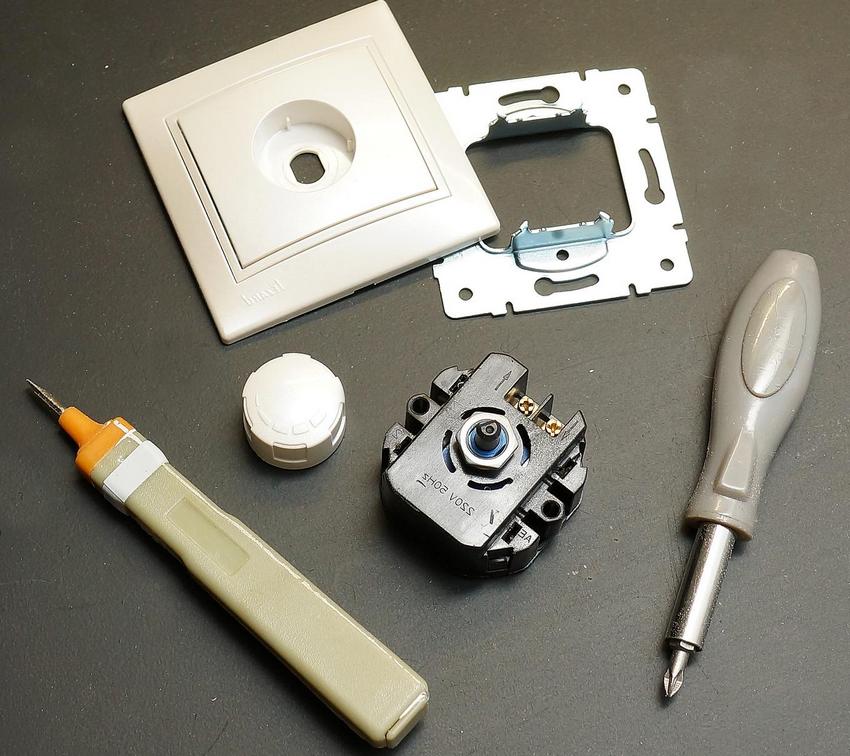
Dimmers not only control the luminous flux, but also contribute to energy saving and longer life of LED lamps
If everything is assembled correctly, and all radio components are in good order, the dimmer will work: when the control element of the device is turned in one direction, the lamp will light up brighter, and when turned in the opposite direction, the glow intensity will decrease, until it is turned off.
Dimmers are successfully used by designers for lighting interior design. After all, experimenting with lighting, you can give the room different shades: from muted and mysterious to bright and invigorating. With the help of dimmers, you can set convenient lighting scenarios and change the familiar environment, getting completely unexpected effects.
